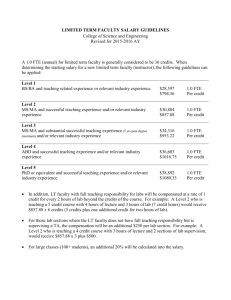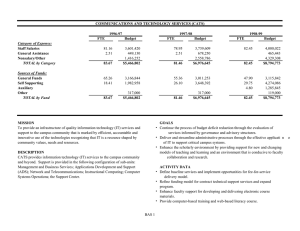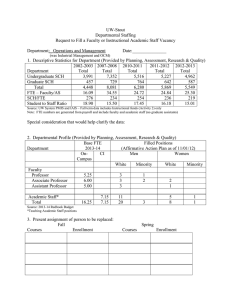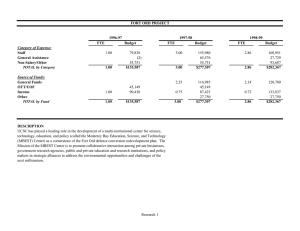January 26, 2001 VICE CHANCELLORS DEANS
advertisement
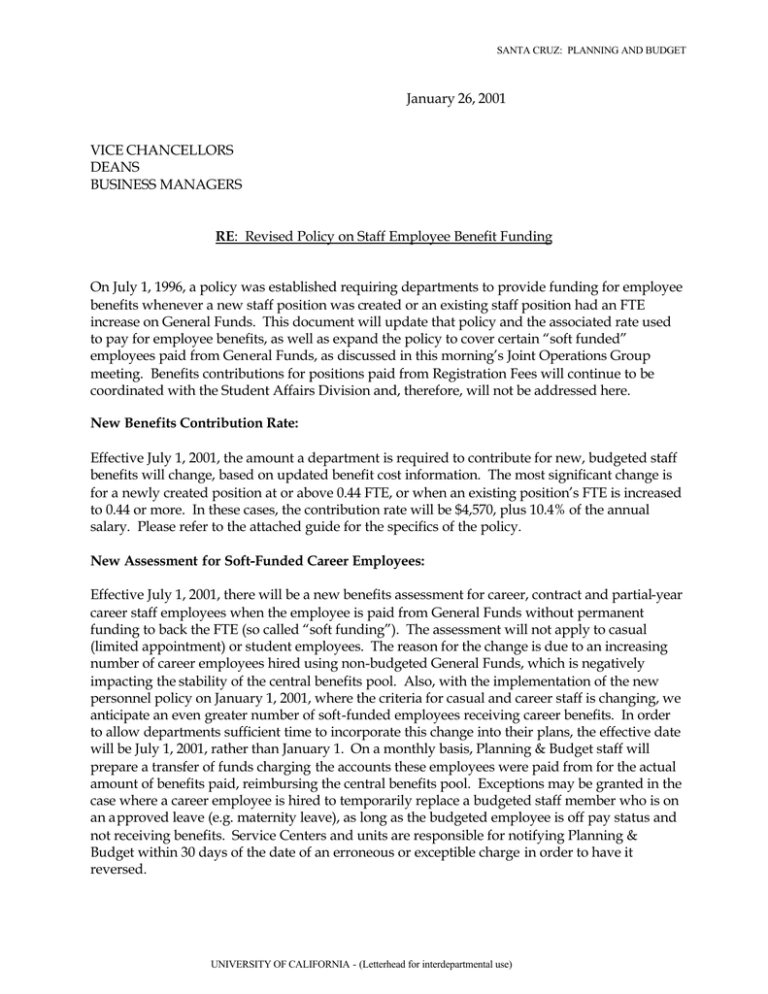
SANTA CRUZ: PLANNING AND BUDGET January 26, 2001 VICE CHANCELLORS DEANS BUSINESS MANAGERS RE: Revised Policy on Staff Employee Benefit Funding On July 1, 1996, a policy was established requiring departments to provide funding for employee benefits whenever a new staff position was created or an existing staff position had an FTE increase on General Funds. This document will update that policy and the associated rate used to pay for employee benefits, as well as expand the policy to cover certain “soft funded” employees paid from General Funds, as discussed in this morning’s Joint Operations Group meeting. Benefits contributions for positions paid from Registration Fees will continue to be coordinated with the Student Affairs Division and, therefore, will not be addressed here. New Benefits Contribution Rate: Effective July 1, 2001, the amount a department is required to contribute for new, budgeted staff benefits will change, based on updated benefit cost information. The most significant change is for a newly created position at or above 0.44 FTE, or when an existing position’s FTE is increased to 0.44 or more. In these cases, the contribution rate will be $4,570, plus 10.4% of the annual salary. Please refer to the attached guide for the specifics of the policy. New Assessment for Soft-Funded Career Employees: Effective July 1, 2001, there will be a new benefits assessment for career, contract and partial-year career staff employees when the employee is paid from General Funds without permanent funding to back the FTE (so called “soft funding”). The assessment will not apply to casual (limited appointment) or student employees. The reason for the change is due to an increasing number of career employees hired using non-budgeted General Funds, which is negatively impacting the stability of the central benefits pool. Also, with the implementation of the new personnel policy on January 1, 2001, where the criteria for casual and career staff is changing, we anticipate an even greater number of soft-funded employees receiving career benefits. In order to allow departments sufficient time to incorporate this change into their plans, the effective date will be July 1, 2001, rather than January 1. On a monthly basis, Planning & Budget staff will prepare a transfer of funds charging the accounts these employees were paid from for the actual amount of benefits paid, reimbursing the central benefits pool. Exceptions may be granted in the case where a career employee is hired to temporarily replace a budgeted staff member who is on an approved leave (e.g. maternity leave), as long as the budgeted employee is off pay status and not receiving benefits. Service Centers and units are responsible for notifying Planning & Budget within 30 days of the date of an erroneous or exceptible charge in order to have it reversed. UNIVERSITY OF CALIFORNIA - (Letterhead for interdepartmental use) Revised Policy on Staff Employee Benefit Funding January 26, 2001 Please contact Troy Lawson (extension 9-4338 or telawson@cats.ucsc.edu) or Free Moini (extension 9-4304 or fbmoini@cats.ucsc.edu) with questions regarding the policy or its implementation. Sincerely, Meredith Michaels Associate Vice Chancellor for Planning and Budget cc: Director Dettman Assistant Vice Chancellor Eckert Senior Analyst Moini Assistant Director Rush Assistant Deans/Assistant to the Deans 2 INSTRUCTIONS AND GUIDELINES FOR EMPLOYEE BENEFIT CONTRIBUTIONS FOR NEW GENERAL FUNDED STAFF POSITIONS General Guidelines: • Contributions will be required for all new staff positions funded by General Funds, as well as existing positions when there is an increase in FTE. Student Affairs will determine the contribution required on staff positions funded by Registration Fees. • The contribution rate may vary annually, depending on changes in the employer contribution rate for health coverage, workers compensation, unemployment insurance, etc. The Planning and Budget Office will periodically review the contribution rate and revise it based on changes in employee benefit costs. • Contributions to the central employee benefit pool must occur at the time the position is established in the permanent budget. • Employee benefit rebates will be made when a staff position is eliminated and will be coordinated with the appropriate dean or vice chancellor. (Note: Open provisions which have not been filled at any time during the previous fiscal year do not qualify for a rebate. In the case of a major reorganization which results in the elimination of several staff positions, the employee benefit rebate is subject to negotiation, unless documentation is produced indicating the unit contributed to the benefit pool for the positions eliminated.) Instructions: To Contribute Benefits 1. Prepare a BSL form to establish the new staff position and a TOF form for the current year proration. The on-line Budget System will automatically calculate the permanent funded portion when a journal is entered; however, a TOF will still need to be prepared for the current year portion. The new position is established in a departmental organization, and the employee benefit contribution is credited to the central employee benefit pool (809999). Employee Benefit contributions for new Registration Fee-funded positions should be coordinated with the VC Student Affairs Office. 2. The employee benefit rate has a fixed rate and a salary driven component. The fixed rate is based on the average cost of dental, health, vision, and employer paid life and disability insurance. For 2000, this cost is $4,570 for all positions which are .44 FTE or more. For positions which are less than .44 FTE, there is no fixed cost. For furloughed positions, the fixed cost will be based on the positions’ percent of full time, rather than the FTE (see example below). The variable rate is based on those benefit costs which are calculated as a percentage of the employee salary (i.e., workers compensation, unemployment insurance, OASDI, etc.) For 2000, this rate is 10.4%, and applies to all new staff positions regardless of FTE, as well as existing staff positions when there is an increase in FTE. EXAMPLE OF EMPLOYEE BENEFIT CALCULATION: Benefits: Fixed Cost @ $4,570 Salary Driven Cost @ 10.4% Total Permanent Benefit Contribution 4,570 4,570 4,570 0 4,570 2,756 1,378 1,295 689 6,240 7,326 (27.6%) 5,948 (44.9%) 5,865 (47.1%) 689 (10.4%) 10,810 (18.0%) New .42 FTE Asst II (50% full 26,500 4,570 1,158 time with 2-mo furlough) Existing .75 FTE Manager 15,000 0 1,560 ($60,000) increased to 1.0 FTE Existing .25 FTE Asst II 6,625 4,570 689 ($26,500) increased to .50 FTE Note that the prorated current year amount would also need to be provided. 5,728 (51.5%) Salary New 1.00 FTE Asst. II New .50 FTE Asst. II New .47 FTE Asst. II New .25 FTE Asst. II New 1.00 FTE Manager 26,500 13,250 12,455 6,625 60,000 1,560 (10.4%) 5,259 (39.7% of total salary) To Receive An Employee Benefit Rebate 1. Prepare a BSL form to delete the staff position. Rebates will be provided at 50% of the contribution calculation noted above or the actual benefits contributed by the department at the time the position was established (which ever is greater). The following table provides an example of how to calculate the employee benefit rebate: Benefits: Salary 1.00 FTE Asst. II .50 FTE Asst. II .25 FTE Asst. II 1.00 FTE Manager 26,500 13,250 6,625 60,000 Reduce 1.0 FTE Asst II to 0.50 FTE 26,500 Fixed Cost @ $4,570 4,570 4,570 0 4,570 Salary Driven Cost @ 10.4% 2,756 1,378 689 6,240 Subtotal 7,326 5,948 689 10,810 Rebate @ 50% 3,663 2,974 345 5,405 None Forward the BSL form to Planning and Budget for completion. Note: Rebates will only be provided for elimination of staff positions which were filled during the previous year, or where the department can provide documentation indicating that employee benefits were contributed to the central benefit pool by the department when the position was initially established. Rebates will not be provided if an FTE is simply reduced, but not eliminated. All benefit rebates will be coordinated with the appropriate dean or vice chancellor.
